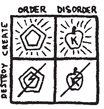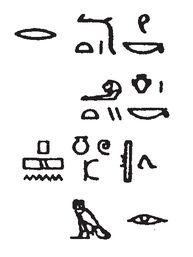Drawing Down the Moon (58 page)
Read Drawing Down the Moon Online
Authors: Margot Adler

Wilson, along with another Erisian named Robert Shea, coauthored
Illuminatus,
a three-volume science fiction/occult/conspiracy novel that takes place in an Erisian framework. Its success in both science fiction and occult circles may prove to be the springboard for more Erisian activity, although the opposite could just as easily occur. In fact, one Erisian magazine in New Jersey published a notice dissolving the local Erisian cabal. The reason: “Since the beans were spilled in the proverbial manner (see
Illuminatus
) it is necessary to retreat to a more esoteric position.”
16
Meanwhile, Malaclypse has given notice that the Eris in the
Principia
and the Eris in
Illuminatus
are
not
the same Eris.
Illuminatus,
a three-volume science fiction/occult/conspiracy novel that takes place in an Erisian framework. Its success in both science fiction and occult circles may prove to be the springboard for more Erisian activity, although the opposite could just as easily occur. In fact, one Erisian magazine in New Jersey published a notice dissolving the local Erisian cabal. The reason: “Since the beans were spilled in the proverbial manner (see
Illuminatus
) it is necessary to retreat to a more esoteric position.”
16
Meanwhile, Malaclypse has given notice that the Eris in the
Principia
and the Eris in
Illuminatus
are
not
the same Eris.
Whichever Eris you choose, she always seems to take the form of paradox, and an Erisian notice printed in
Green Egg
said that the Erisian path generally appealed to those who have “an affinity toward taoism, anarchy and clowning; who can feel comfortable in a Neo-Pagan context; and who probably have a tendency toward iconoclasm.”
17
Green Egg
said that the Erisian path generally appealed to those who have “an affinity toward taoism, anarchy and clowning; who can feel comfortable in a Neo-Pagan context; and who probably have a tendency toward iconoclasm.”
17
And Discordianism plans to stay humorous. Wilson says, “Much of the Pagan movement started out as jokes, and gradually, as people found out they were getting something out of it, they became serious. Discordianism has a built-in check against getting too serious. The sacred scriptures are so absurdâas soon as you consult the scriptures again, you start laughing. Discordian theology is similar to Crowleyanity. You take any of these ideas far enough and they reveal the absurdity of all ideas. They show that ideas are only tools and that no idea should be sacrosanct. Thus, Discordianism is a necessary balance. It's a fail-safe system. It remains a joke and provides perspective. It's a satire on human intelligence and is based on the idea that whatever your map of reality, it's ninety percent your own creation. People should accept this and be proud of their own artistry. Discordianism can't get dogmatic. The whole language would have to change for people to lose track that it was all a joke to begin with. It would take a thousand years.”
The Erisian position on humor has always been clear, and to prove it, here is another section from the sacred scriptures, the
Principia.
18
Principia.
18
Â
THE DISCORDIAN SOCIETY
Joshua Norton Cabal
San Francisco

In the year 1166 B.C., a malcontented hunchbrain by the name of Greyface, got it into his head that the universe was as humorless as he, and he began to teach that play was sinful because it contradicted the ways of Serious Order. “Look at all the order about you,” he said. And from that, he deluded honest men to believe that reality was a straightjacket affair and not the happy romance as men had known it.
It is not presently understood why men were so gullible at that particular time, for absolutely no one thought to observe all the
disorder
around them and conclude just the opposite. But anyway, Greyface and his followers took the game of playing at life more seriously than they took life itself and were known even to destroy other living beings whose ways of life differed from their own.
disorder
around them and conclude just the opposite. But anyway, Greyface and his followers took the game of playing at life more seriously than they took life itself and were known even to destroy other living beings whose ways of life differed from their own.
The unfortunate result of this is that mankind has since been suffering from a psychological and spiritual imbalance. Imbalance causes frustration, and frustration causes fear. And fear makes a bad trip. Man has been on a bad trip for a long time now.
It is called THE CURSE OF GREYFACE.
Â
The Curse of Greyface and The Introduction of Negativism
To choose order over disorder, or disorder over order, is to accept a trip composed of both the creative and the destructive. But to choose the creative over the destructive is an all-creative trip composed of both order and disorder. To accomplish this, one need only accept creative disorder along with, and equal to, creative order, and also be willing to reject destructive order as an undesirable equal to destructive disorder.
The Curse of Greyface included the division of life into order/ disorder as the essential positive/negative polarity, instead of building a game foundation with creative/destructive as the essential positive/ negative. He has thereby caused man to endure the destructive aspects of order and has prevented man from effectively participating in the creative uses of disorder. Civilization reflects this unfortunate division.

POEE proclaims that the other division is preferable, and we work toward the proposition that creative disorder, like creative order, is possible and desirable; and that destructive order, like destructive disorder, is unnecessary and undesirable.
Seek the Sacred Chaoâtherein you will find the foolishness of all ORDER/DISORDER. They are the same!
Principia Discordia or How I found Goddess and what I did to Her when I found Her

And yet Erisianism should not be treated frivolously. Greg Hill told me his experiences with Eris had been quite profound. Although it started as an atheistic joke, his perceptions began to change.
“Eris is an authentic goddess. Furthermore, she is an old one. In the beginning I saw myself as a cosmic clown. I characterized myself as Malaclypse the Younger. But if you do this type of thing well enough, it starts to work. In due time the polarities between atheism and theism became absurd. The engagement was transcendent. And when you transcend one, you have to transcend the other. I started out with the idea that all gods are an illusion. By the end I had learned that it's
up to you
to decide whether gods exist, and if you take a goddess of confusion seriously, it will send you through as profound and valid a metaphysical trip as taking a god like Yahweh seriously. The trips will be different, but they will both be transcendental. Eris is a valid goddess in so far as gods are valid; and gods are valid when we choose them to be. The Christian tradition has become so totally alienated from reality in the Western world that people have had to start inventing their own damn gods. Some people are doing it seriously and it is validly working. The Neo-Pagan phenomenon is an example. Another path would be transcendental atheism: using atheism as a spiritual path. The phenomenon of Eris is a hybrid between the two. She is an absurdist deity who shows that nonsense is as valid as sense, since Eris is as preposterous a deity as ever invented. Yet, if you pursue her, it can be a valid spiritual experience that can carry you to the point where you no longer relate to things in terms of deities and nondeities.”
up to you
to decide whether gods exist, and if you take a goddess of confusion seriously, it will send you through as profound and valid a metaphysical trip as taking a god like Yahweh seriously. The trips will be different, but they will both be transcendental. Eris is a valid goddess in so far as gods are valid; and gods are valid when we choose them to be. The Christian tradition has become so totally alienated from reality in the Western world that people have had to start inventing their own damn gods. Some people are doing it seriously and it is validly working. The Neo-Pagan phenomenon is an example. Another path would be transcendental atheism: using atheism as a spiritual path. The phenomenon of Eris is a hybrid between the two. She is an absurdist deity who shows that nonsense is as valid as sense, since Eris is as preposterous a deity as ever invented. Yet, if you pursue her, it can be a valid spiritual experience that can carry you to the point where you no longer relate to things in terms of deities and nondeities.”
For Wilson also, Discordianism is a perceptual game, a means of expanding one's perception of reality. The Discordian position, he has written, “demands, then, continuous motion. To stop at any one metaphor and establish it as dogma is to put the mind in chains.” He adds, “Although Discordians move about the country and the world constantly, in many guises, there is always one major Discordian ashram in the San Francisco Bay Area âon the site of the beautiful future San Andreas Canyon.' The only way to remain sane is to
know
that the ground below you is pure Void.”
19
know
that the ground below you is pure Void.”
19
I asked Malaclypse, “What's Omar Ravenhurst doing these days?” He said, “Ravenhurst has recently been in a state of extreme discord. We were talking about Eris and confusion and he said, âYou know, if I had realized that all of this was going to come
true,
I would have chosen Venus.'”
The Erisian Movement Todaytrue,
I would have chosen Venus.'”
Discordians and Erisians still make their presence known at Pagan gatherings and in the pages of newsletters. And there are many Erisian sites on the Web (see Resources). Dennis Moskowitz (Brother Max Flax Beeblewax), who was part of the Five-College Discordian Society of Saint Rufus a number of years ago, writes that what's most noticeable now is the influence of Eris in the culture at large. “Most Pagans and magicians seem to be familiar with Discordianism,” he says. Moskowitz notes that Eris was one of the main charactersâalbeit a villainâin a recent Sinbad animated movie, and Discordian references can be found in Grant Morrison's 1994â2000 comic series,
The Invisibles.
There is a role-playing game created by designer John Wick called
Discordia!
It is free to the public. There were some Discordian protests of the movie
Troy
because it told the story of the Trojan War without mentioning any gods, and therefore denied the role of the Goddess Eris in starting the war. Moskowitz observes that Discordianism “will always be a movement that begins with high school and college students who discover it, perhaps take it too seriously, mellow out as they get older,” but then, every so often, Erisian elements will wind up in their future artistic work.
The Invisibles.
There is a role-playing game created by designer John Wick called
Discordia!
It is free to the public. There were some Discordian protests of the movie
Troy
because it told the story of the Trojan War without mentioning any gods, and therefore denied the role of the Goddess Eris in starting the war. Moskowitz observes that Discordianism “will always be a movement that begins with high school and college students who discover it, perhaps take it too seriously, mellow out as they get older,” but then, every so often, Erisian elements will wind up in their future artistic work.
Another Discordian, who calls herself Elfwreck, notes that Eris is a recurring villain in the Cartoon Network show
The Grim Adventures of Billy and Mandy.
She also says there is an annual Discordian convention called
KallistiCon a Discordian (un) Convention,
usually in California. And at PantheaCon, an annual Pagan convention in northern California, there is usually a Discordian ritual attended by a couple hundred people. There are also occasional pilgrimages to Emperor Norton's gravesite. A member of the Avatar Jones Memorial Cabal (AJMC) is in the process of starting an Erisian church, the Fifth Trinity Church. Elfwreck said the Discordian/Erisian movement was as strong as it ever was, “which is to say, there are tiny clots here and there with delusions of grandeur, and the illusion of a much larger web connecting all the dots.” Elfwreck says that the fact that public Paganism has developed a tolerance for Discordians “rather shocks me,” and she says it may well show the superficiality of much of Paganism.
The Grim Adventures of Billy and Mandy.
She also says there is an annual Discordian convention called
KallistiCon a Discordian (un) Convention,
usually in California. And at PantheaCon, an annual Pagan convention in northern California, there is usually a Discordian ritual attended by a couple hundred people. There are also occasional pilgrimages to Emperor Norton's gravesite. A member of the Avatar Jones Memorial Cabal (AJMC) is in the process of starting an Erisian church, the Fifth Trinity Church. Elfwreck said the Discordian/Erisian movement was as strong as it ever was, “which is to say, there are tiny clots here and there with delusions of grandeur, and the illusion of a much larger web connecting all the dots.” Elfwreck says that the fact that public Paganism has developed a tolerance for Discordians “rather shocks me,” and she says it may well show the superficiality of much of Paganism.
Some Pagans argue that since Erisianism is mostly playful nonsense, people leave it once they get into Paganism more seriously. An entry on a Pagan scholars list read “The jokes get tiresome . . . perhaps the movement has lost steam.” The writer adds that any real reading of Greek writers like Hesiod shows Eris to be the mother of all harmâand not a goddess to emulate.
But others would argue that the Pagan community is one of the only spiritual communities that is exploring humor, joy, abandonment, even silliness and outrageousness as valid parts of spiritual experience. Oz, a Craft priestess from New Mexico, wrote these words to me, just days before the 1986 edition of
Drawing Down the Moon
went to press.
Drawing Down the Moon
went to press.
The Pagan movement is exploring social change in a way that I don't see it done anywhere else. We are living with nudity, sexual freedom, license for experimentation, freedom of thought and a loose, fun joy that is unique. I don't see other “magickal” people developing a culture of boisterous joy. To find it in expression, silliness, outrageousness, pushing the limitsâto find that in this there is spirit. If you think about the dual meaning of the word “spirit” for a moment, I think you have it. I now get much of my intellectual and even spiritual stimulation from people who are not Witches or Pagans, but when I want to be around people with whom I am comfortable living my life the way I like to live it, who are being exceedingly open about everything from soup to nuts, who won't think you're crazy if you express a silly desire and act on it, I hang out with Pagans.
There are now many places where you can find alternatives to patriarchal Christian culture, places that are open to the mystical and the feminine. What exists in Paganism is the exposure to others that aren't afraid to dream a different dream and try to live it. We're not following anybody. We are like explorers on a new planet in some ways. And we say as Discordians say, “Don't make plans.”
Other books
The Redeemer by J.D. Chase
Escape to Morning by Susan May Warren
The Book of Mordred by Vivian Vande Velde
Be My Baby by Meg Benjamin
Mr. Forrester: An Alpha Billionaire Romance by Landish, Lauren
Ride to Fight: A Biker Erotic Romance (Free Guns MC) by Wilson, Joanna
The Girl Who Blew Up Her Brother and Other Naughty Stories for Good Boys and Girls by Christopher Milne
Dead In The Hamptons by Zelvin, Elizabeth
14 BOOK 2 by J.T. Ellison
The Curse of Snake Island by Brian James
